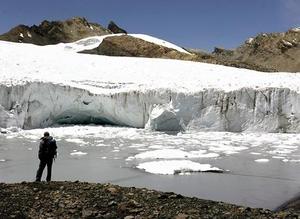Infrastructure protectionMelting glaciers threaten Peru
Rising temperatures have caused glaciers in Peru to melt at alarming rates; Peru depends heavily on rivers fed by glaciers to provide drinking water, irrigation, and electricity; some scientists estimate that in ten years, whole glaciers will disappear entirely from the Andes; millions of Peruvians depend entirely on the glacier fed rivers as their primary source for water; the United States fears that water, food, and power shortages in Peru could cause stability and spark conflict across the region

Peru's Pastoruri glacier // Source: democraticunderground.com
Melting glaciers in the South American Andes are threatening Peru’s stability as they are the foundation of the country’s drinking water, irrigation, and electricity.
The Washington Post reports that some scientists estimate that in ten years, whole glaciers will disappear entirely from the Andes.
Peru depends on its eighteen mountain glaciers to provide water for drinking, farming, and electricity. Rising temperatures caused by climate change have already devastated fish stocks and crops.
Peru’s climate change adviser at the Ministry of Foreign Affairs, Alberto Hart, is concerned that if projects to conserve water, improve ancient water infrastructure, and regulate runoff from glaciers are not initiated, the rapidly vanishing Andean glaciers could result in a social and economic disaster.
Lima, a city of nine million people, depends heavily on rivers that are fed by the glaciers in the Cordillera Central Mountains. With some mountains losing more than 60 percent, Lima is facing critical shortages of water in the future.
The glacial runoff from the Cordillera Blanca Mountains feed rivers that provide more than two million people with drinking water and irrigation.
According to Cesar Portocarrero, the Peruvian government’s top glacier scientist, since 1970 Cordillera Blanca has lost 30 percent of its glaciers.
Maximo Juan Malpaso Carranza, a farmer living in Cordillera Blanca Mountains, says, “It used to take you two or three hours walking to reach the ice. But now you have to walk five, six hours to reach ice.”
Carranza is particularly concerned because the glaciers are the community’s primary source of water.
“We all get water from there,” he said. “But if the ice disappears, there won’t be any more water.”
Rivers fed by glacier runoffs also support the nation’s largest hydroelectric plants, putting Peru’s energy resources at risk. Food sources are also in danger as much of Peru’s agriculture is fed by waters from the Andes.
Peru is requesting financial aid from the United States and its other allies asking for at least $350 million dollars a year until 2030 to construct reservoirs, dams, and irrigation projects.
The United States has a keen interest as government officials are concerned that these water shortages will destabilize the country and create broader problems for the region.
Former CIA director R. James Woolsey explains, “Think what it would be like if the Andes glaciers were gone and we had millions and millions of hungry and thirsty Southern neighbors.”
About 70 percent of the world’s tropical glaciers are located in Peru, and they extend into Bolivia, Ecuador, and Chile.
Water has already created many conflicts in southern Peru over the past several years and will likely cause more as water supplies dwindle. Maj. Gen. Luis Palomino Rodriguez, the head of Peru’s National Civil Defense Institute, worries that these conflicts may even spill into neighboring countries.
The U.S. Agency for International Development (USAID) has received $1.25 million in funding to work with a Peruvian non-profit to assist communities living in the mountains adapt to the melting glaciers.
The United States gave $30 million in climate change assistance to Peru in 2010 primarily to preserve the Amazon rainforest.
